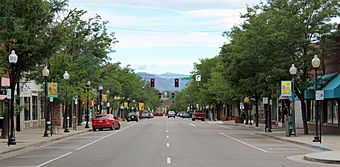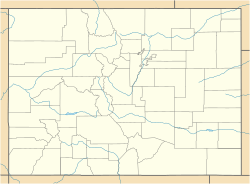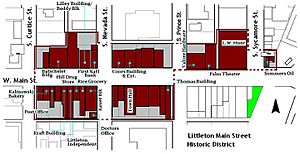Littleton Main Street facts for kids
Quick facts for kids |
|
|
Littleton Main Street
|
|
 |
|
| Location | Roughly along W. Main St., from S. Curtice St. to S. Sycamore St., Littleton, Colorado |
|---|---|
| Area | 8 acres (3.2 ha) |
| Architect | Jules J.B. Benedict |
| Architectural style | Early Commercial, Italianate, Moderne |
| NRHP reference No. | 98000291 |
| Added to NRHP | April 8, 1998 |
The Littleton Main Street is a special area in Littleton, Colorado. It's called a historic district because it has many old and important buildings. These buildings are found along West Main Street, from South Curtice Street to South Sycamore Street.
This district started way back in 1890. Many of the buildings from the late 1800s are made of red pressed brick. They often have strong stone foundations and fancy stone decorations. These solid buildings replaced older, simpler wooden ones. They showed how successful the people who built them were!
Exploring Historic Buildings
A historic district is like an outdoor museum. It helps us understand how a town grew and changed over time. The buildings on Littleton Main Street tell stories about the past. Let's look at some of the cool buildings you can find here.
Buildings on West Main Street
Many interesting buildings line West Main Street. Each one has its own history and unique style.
Sommers Oil Service Station
- 2299 West Main Street, Sommers Oil Service Station, built in 1922.
This building shows how cars started to change towns. The Sommers Oil Company from Denver built it. It was first two separate buildings: one for filling up cars and another for greasing them. Later, they were joined together. The building is made of concrete blocks and has a unique roof style.
I.W. Hunt Ford Dealership
- 2329 West Main Street, I.W. Hunt Building, built in 1919.
This large building was once a Ford car dealership. Ivy W. Hunt opened it in 1919. It's made of red brick with cool white brick designs that look like the letter "H." The building has big display windows where cars were shown off. In the 1980s, a new part was added to the top. It was designed to blend in with the old building.
Palm Theater
- 2359 West Main Street, Palm Theater, built in 1925.
As movies became popular, J.H. Peterson built the Palm Theater. It was a tall, one-story building with a flat roof. It had a central entrance with big windows. The theater only operated for a few years. By the 1930s, it was changed into a department store.
Valore Hardware Store
- 2379-99 West Main Street, Valore Hardware, built in 1925.
A.J. Valore built this one-story brick building. It housed his hardware store and two other businesses. The building has three separate storefronts facing Main Street. It features red and white brick designs.
Littleton Town Hall
- 2450 West Main Street, Littleton Town Hall, built in 1920.
This building is very special! The architect, J.J.B. Benedict, was inspired by a famous building in Italy. The front of the Town Hall looks like stone. It has three pointed arch entrances. Above these, there are more arches and windows with fancy decorations. This building is so important that it's listed on the National Register of Historic Places.
Coors Building
- 2489 West Main Street, Coors Building, built in 1905.
Adolph Coors, from Golden, built this large two-story building. It had five shops on the ground floor. Upstairs, there was a club for gentlemen. The building is made of buff-colored brick. It has "COORS" plaques on the top. It's another important landmark in Littleton.
First National Bank
- 2509 West Main Street, First National Bank of Littleton, built in 1905.
This two-story building was built by the First National Bank and local residents. It has a unique roof with short brick pillars and a zigzag pattern. The first floor had large display windows.
Littleton Independent Newspaper
- 2546 West Main Street, Littleton Independent, built in 1906.
The Littleton Independent was the town's longest-running newspaper. They built this two-story building for their office and printing press. It has arched windows on the second floor. The first floor had a central entrance and display windows.
Littleton Post Office
- 2580 West Main Street, Littleton Post Office, built in 1893.
This two-story brick building was one of the early locations for the Littleton post office. It has fancy decorations and windows with arched tops.
Buildings on Side Streets
Some historic buildings are also found on the streets just off Main Street.
Franzen Grocery
- 5686 South Sycamore Street, Franzen Grocery, built in 1920.
Cornelius Franzen built this one-story grocery store. It has a flat roof and a metal awning over the entrance.
Medical Offices
- 5717 South Nevada Street, Medical Offices, built in 1951.
This two-story brick building was designed in the Art Moderne style. This style often has curved corners and smooth lines. This building features cool glass blocks and a curved entrance. It used to house doctors' offices.
Images for kids





